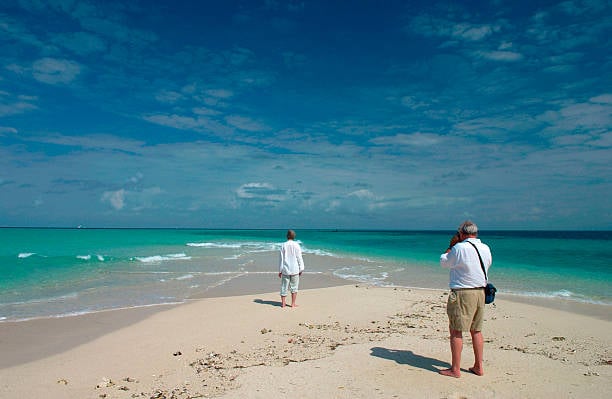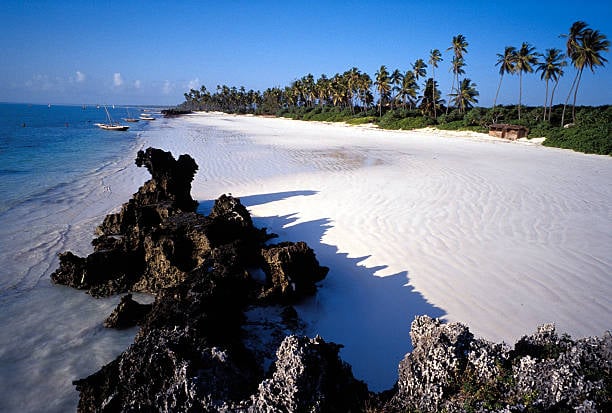Zanzibar March Weather: What to Expect for Your Visit


Zanzibar, a tropical paradise in the Indian Ocean, is a dream destination for travelers seeking sun, sand, and culture.
March in Zanzibar signals the beginning of the long rainy season, characterized by a blend of hot, sunny days and brief, intense thunderstorms.
While rain becomes more frequent, it rarely lasts all day, allowing plenty of opportunities to enjoy outdoor activities.
Daytime temperatures in March average around {{temperature_celsius}} ({{temperature_fahrenheit}}), with plenty of sunshine and a refreshing breeze. Evenings are slightly cooler, with nighttime lows hovering around {{min_temperature_celsius}} ({{min_temperature_fahrenheit}}), creating ideal conditions for exploring Stone Town, enjoying nightlife, or taking a dip in the warm ocean waters.
Rainfall in March averages {{precipitation}}, spread across the month, with {{rainy_days}} rainy days. Showers are often short but intense, typically occurring in the afternoon or evening.
Despite the rain, Zanzibar still enjoys an average of 9 hours of sunshine per day, ensuring ample time for beach outings, snorkeling, and diving.
However, as the month progresses, the frequency of rain increases, marking the transition into the long rainy season.
Humidity levels remain high during March, adding to the tropical feel of the island. While the weather can be unpredictable, the mix of sunshine and rain keeps the landscape lush and vibrant.
Travelers should come prepared with lightweight, breathable clothing, a rain jacket, and sunscreen to adapt to the changing conditions.
By mid-March, diving conditions begin to shift as the long rains become more consistent. However, early March still offers excellent visibility for underwater adventures.
Whether you’re lounging on the beach, exploring the island’s cultural gems, or diving into its rich marine life, Zanzibar’s March weather provides a unique and memorable experience.
Best Time to Visit Zanzibar

A tourist films a young man leaping into the sea with a sign reading "Welcome to Zanzibar" in Stone Town
The best time to visit Zanzibar depends on your preferences, travel plans, and the type of experience you’re seeking. Each season offers something unique, making the island a year-round destination.
For those who prefer sunny skies and minimal rain, the long dry season from June to October is ideal.
During these months, Zanzibar enjoys clear weather, making it perfect for beach activities, diving, and exploring the island’s cultural landmarks. This period is also the peak tourist season, so expect larger crowds and higher prices.
March, on the other hand, falls within the long rains, offering a different but equally appealing experience.
While the weather can be unpredictable, with hot sunny days interrupted by tropical downpours, this time of year has its own charm.
The rain keeps the island lush and vibrant, and the occasional showers often pass quickly, leaving plenty of time for exploration.
One of the biggest advantages of visiting Zanzibar in March is the lower number of tourists.
As it’s considered the low season, you’ll find fewer crowds at popular attractions, more affordable accommodation, and a more relaxed atmosphere. This makes March a great time for travelers seeking a quieter holiday or those who enjoy the dramatic beauty of tropical weather.
Whether you visit during the dry season for perfect beach days or in March for a unique blend of sunshine and rain, Zanzibar promises an unforgettable experience.
Each season has its own appeal, ensuring there’s always a great time to explore this tropical paradise
Activities and Events

Camilla, Duchess of Cornwall and Prince Charles, Prince of Wales visit a gift shop in Stone Town in Zanzibar
March is a fantastic time to visit Zanzibar, offering a mix of cultural experiences, outdoor adventures, and relaxation. With fewer crowds and a laid-back atmosphere, visitors can enjoy the island’s treasures at their own pace.
One of the highlights of March is the Sauti za Busara Music Festival, held in Stone Town. This vibrant event transforms the Old Fort into a lively hub of African music, drawing performers and visitors from across the continent. It’s a must-see for anyone looking to immerse themselves in Zanzibar’s rich cultural scene.
For history enthusiasts, Stone Town is a treasure trove of ancient ruins and landmarks.
Explore the Mbweni Ruins, Ngome Kongwe (The Old Fort), and the Hamamni Persian Baths, each offering a glimpse into the island’s fascinating past.
Walking through the narrow streets of Stone Town feels like stepping back in time, with its blend of Arab, Persian, Indian, and European influences.
Nature lovers will find plenty to enjoy as well.
Zanzibar’s pristine beaches along the Indian Ocean are perfect for sunbathing, swimming, or simply relaxing with a book.
The warm waters are also ideal for snorkeling and diving, especially early in the month before the rains become more frequent.
Spice tours are another popular activity, allowing visitors to explore Zanzibar’s famous spice farms.
Learn about the island’s role in the spice trade and sample fresh cloves, cinnamon, and nutmeg. It’s a sensory experience that adds depth to any trip.
With its unique blend of culture, history, and natural beauty, Zanzibar in March offers something for everyone.
Whether you’re dancing to the rhythms of African music, exploring ancient ruins, or unwinding on a tranquil beach, this tropical paradise ensures an unforgettable experience.
Marine Adventures

Snorkelers in Matemwe Resort
March is an excellent time for marine adventures in Zanzibar, with warm sea temperatures and clear visibility making it ideal for diving and snorkeling.
The Indian Ocean waters around the island average around 30°C (86°F), providing comfortable conditions for swimming and water-based activities.
Underwater visibility remains superb during this time, offering breathtaking views of vibrant coral gardens and a diverse array of marine life.
From colorful tropical fish to sea turtles and dolphins, Zanzibar’s waters are teeming with natural wonders.
Early March, in particular, is perfect for diving, as the long rains have yet to significantly impact visibility.
For those new to diving or snorkeling, Zanzibar offers numerous guided tours and beginner-friendly spots.
Whether you’re exploring the famous Mnemba Atoll or the reefs off the coast of Nungwi, the island’s underwater world promises unforgettable experiences.
Here’s a quick guide to making the most of your marine adventures in March:
Diving Conditions: Early March offers the best visibility, with calm waters and minimal rain. Popular sites include Mnemba Atoll and Leven Bank.
Snorkeling: Easily accessible from the beaches, snorkeling spots like Kendwa and Paje are perfect for all skill levels.
Marine Life: Keep an eye out for tropical fish, sea turtles, and even dolphins during your underwater explorations.
Coral Gardens: Explore the vibrant coral reefs, home to a variety of marine species and stunning underwater landscapes.
Tips: Bring waterproof sunscreen, a reusable water bottle, and consider booking a guided tour for the best experience.
Whether you’re an experienced diver or a first-time snorkeler, Zanzibar’s marine adventures in March offer something for everyone. Dive into the warm waters of the Indian Ocean and discover the island’s underwater paradise.
Tips for Visiting Zanzibar in March

Visiting Zanzibar in March offers a unique blend of sunny days and occasional rain, making it essential to plan ahead for a smooth and enjoyable trip.
Here are some practical tips to help you make the most of your visit:
Pack Smart for Changing Weather: March weather patterns can be unpredictable, with sunny mornings and sudden afternoon showers. Bring lightweight, breathable clothing for the heat, a waterproof jacket for rainy days, and sturdy footwear for exploring. Don’t forget sunscreen and a hat for sun protection.
Check Daily Forecasts: Stay updated on weather patterns by consulting local tour operators or reliable weather apps. This will help you plan activities like beach outings, spice tours, or water sports around the rain.
Stay Safe During Water Activities: While the Indian Ocean is warm and inviting, always prioritize safety. Swim in designated areas, follow guidelines from local guides, and avoid venturing too far out during rough weather. If you’re diving or snorkeling, choose reputable operators with certified instructors.
Embrace the Rainy Days: Don’t let occasional showers dampen your spirits. Use rainy days to explore indoor attractions like Stone Town’s historical sites, spice farms, or local markets. These experiences offer a deeper connection to Zanzibar’s culture and traditions.
Plan for Relaxation: March’s quieter atmosphere makes it an ideal time for relaxation. Whether you’re lounging on the soft sands of Nungwi Beach, enjoying a spa day, or savoring fresh seafood at a beachfront restaurant, take time to unwind and soak in the island’s coastal beauty.
By preparing for both sunny and rainy conditions, staying informed about weather patterns, and prioritizing safety, you can ensure a memorable and stress-free trip to Zanzibar in March. island’s coastal beauty remains a highlight of any visit, despite occasional showers.
Accommodation and Tourist Season

March is considered the mid-season in Zanzibar, offering a perfect balance between affordability and tranquility.
With fewer tourists compared to the peak months, visitors can enjoy a more relaxed and intimate experience on the island.
One of the biggest advantages of traveling during this time is the affordable prices for accommodations and activities.
From luxury resorts like The Zanzibar Serena Hotel and Baraza Resort & Spa to boutique options such as Matlai Boutique Hotel and Dhow Palace Hotel, there’s something for every budget.
Many properties offer discounted rates, making it easier to enjoy a high-quality stay without breaking the bank.
Activities such as spice tours, diving, and cultural excursions are also more budget-friendly during this period.
The quieter atmosphere allows for greater relaxation and a chance to fully immerse yourself in Zanzibar’s natural beauty and rich culture.
Whether you’re lounging on pristine beaches, exploring Stone Town’s historic streets, or indulging in fresh seafood at a beachfront restaurant, March provides the ideal setting for a peaceful and memorable vacation.
Safety and Precautions
Traveling to Zanzibar in March requires some preparation due to the island’s transitional weather.
Be ready for occasional rain showers and thunderstorms, which can occur unexpectedly.
Pack a lightweight rain jacket, waterproof bags for electronics, and quick-dry clothing to stay comfortable.
When engaging in water activities like snorkeling or diving, prioritize safety by choosing reputable tour operators with certified guides.
Always follow local advice and avoid venturing too far out during rough weather.
Staying informed about daily weather patterns through reliable sources or your tour operator can help you plan activities safely and effectively.
Cultural Experiences in Zanzibar
Zanzibar is a treasure trove of cultural experiences, with Stone Town at its heart.
This UNESCO World Heritage city is home to architectural gems like the House of Wonders and the Arab Fort, both of which offer a glimpse into the island’s rich cultural heritage.
Wander through the narrow, winding streets to discover bustling markets, intricately carved doors, and vibrant local life.
Food lovers will delight in Zanzibar’s local cuisine, which blends African, Arab, and Indian influences.
Don’t miss trying dishes like Zanzibar pizza, urojo soup, and freshly caught seafood. As the sun sets, the island comes alive with a lively nightlife scene.
From rooftop bars in Stone Town to beachfront lounges in Nungwi, there’s something for everyone to enjoy.
Combining Zanzibar with a Safari
Many travelers pair their Zanzibar getaway with a safari in Tanzania, creating the ultimate East African adventure.
The Serengeti National Park is a highlight, especially for witnessing the iconic wildebeest migration.
While the migration occurs year-round, its location shifts based on rainfall patterns, so plan your visit with the help of experienced guides.
Combining Zanzibar’s pristine beaches with the thrill of a safari offers the best of both worlds.
Flights between Zanzibar and mainland Tanzania are frequent, making it easy to transition from island relaxation to wildlife exploration.
Getting Around
Zanzibar is a compact island, making it easy to explore.
Daily flights connect Zanzibar to destinations like the Serengeti, while local tour operators provide reliable transportation services for getting around the island.
Taxis, dala-dalas (local minibuses), and rented scooters are popular options for shorter trips.
For a hassle-free experience, consider booking tours or private transfers through reputable operators. This ensures you can focus on enjoying your trip without worrying about logistics.
Budget and Planning
Traveling to Zanzibar in March, during the low season, offers significant savings on accommodations and activities.
Many affordable resorts and boutique hotels provide discounted rates, making it easier to enjoy a luxurious stay without overspending.
To make the most of your trip, plan ahead by booking accommodations and activities in advance.
This ensures availability and allows you to tailor your itinerary to your preferences.
Whether you’re on a tight budget or looking to splurge, Zanzibar offers options for every traveler.
FAQs About Zanzibar Weather in March
What is the average temperature in Zanzibar during March?
The average temperature in March ranges from 24°C (75°F) at night to 32°C (90°F) during the day, offering warm and humid conditions.How is Zanzibar weather in March?
Zanzibar weather in March is transitional, with sunny mornings, occasional afternoon showers, and high humidity. It’s the tail end of the short rains, so heavy rainfall is possible but rarely lasts all day.Are daytime temperatures in March suitable for outdoor activities?
Yes! Daytime temperatures hover around 28–32°C (82–90°F), ideal for beach trips, snorkeling, and exploring Africa’s cultural gems.When is Zanzibar’s main rainy season?
The main rainy season (or long rains) typically runs from April to May. March marks the transition, with sporadic short rains.Is mid-March a good time to visit?
Mid-March offers fewer crowds and lower prices, though rainfall becomes slightly higher as the month progresses.What makes Zanzibar unique in March?
Zanzibar marks the shift between seasons, blending lush greenery from the short rains with warm, sunny intervals perfect for a holiday.How does March compare to July in Zanzibar?
Unlike July (peak dry season with clear skies), March has more humidity and rain. However, July is ideal for safaris in Tanzania and Africa.What’s the possibility of rain ruining a week-long trip?
While heavy rainfall can occur, showers are usually brief. Pack for both sun and rain to enjoy your week in Africa’s tropical paradise.Is March the hottest month in Zanzibar?
No, January is the hottest month. March temperatures are warm but tempered by breezes and occasional rain.Are nights cooler in March?
Night temperatures average 24°C (75°F), perfect for sunset strolls in Stone Town or beachside dinners.What are the best months to visit Zanzibar?
The best months are June–October (dry season) and January–February (hot, dry weather). March is great for travellers seeking fewer crowds.Can I see the wildebeest migration in Tanzania during March?
Yes! The Serengeti migration in Tanzania is year-round. March falls during calving season in southern Africa, influenced by rainfall patterns.How much daylight is there in March?
Enjoy about 12 hours of daylight, with sunrise around 6:15 AM and sunset near 6:30 PM—ideal for maximizing your trip.Is humidity a problem in March?
Humidity levels are high (75–80%), but coastal breezes and clear skies in the mornings help balance the tropical feel.
Conclusion
Zanzibar in March is a unique destination, offering a mix of tropical weather, fewer crowds, and vibrant cultural experiences.
From exploring Stone Town to relaxing on pristine beaches, the island has something for everyone. While the rainy season brings occasional showers, it also keeps the landscape lush and the atmosphere tranquil.
By carefully planning your visit to Zanzibar, you can enjoy an unforgettable trip that combines relaxation, adventure, and cultural discovery.
Whether you’re traveling solo, as a couple, or with family, Zanzibar in March promises a memorable escape



